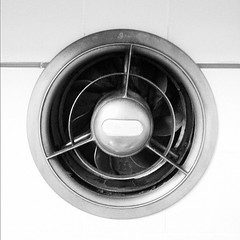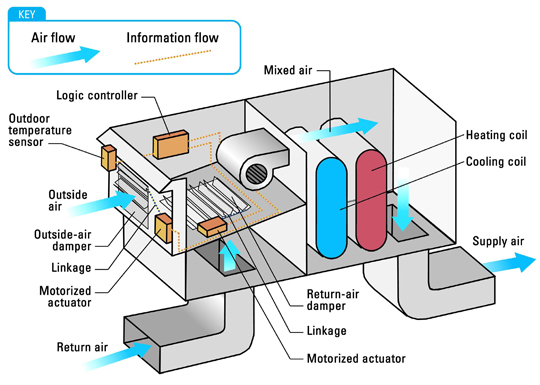From building trades and commissioning work, I’ll occasionally notice something off-the-job about a particular building HVAC system, and it may become a distraction (though my wife may classify it as an obsession). I think we, as humans, are all prone to do this—examples include the English teacher that can’t stand the misapplication of “lay” vs “lie” by people outside of the classroom setting (my 95 year old former English teacher grandmother, for one), or the chef who may have trouble enjoying other people’s food without having to over-think the ingredients or preparation, and the like. Well, as you can imagine, this happens to HVAC engineers as well and today my “distraction” concerns commercial kitchen exhaust imbalance.
 (Photo by Flickr user Meng He)
(Photo by Flickr user Meng He)Comfort Issues Affect Business
By this I am referring to insufficient outdoor air makeup in restaurants (to replace the kitchen exhaust) which results in the space being very negatively pressurized. Regardless of the specific cause for this situation, you know it when you see it—outside restaurant doors difficult to open because they are “sucked” shut, or blasts of cold air rocketing past you when exiting in the winter to satisfy the space negative. My favorite example of this is a pizza restaurant somewhere in Vermont (specifics redacted to protect the guilty, and one of my favorite establishments) where pizza boxes can almost be blown out of your hands by the wind rushing in as you walk out of the front door. Several times while passing by this establishment I’ve even seen potential customers attempt to open the front door, conclude that the place is closed because the door doesn’t budge, and move on down the street. In this same establishment, floor-to-ceiling heavy black curtains are hung directly inside the front door to create a vestibule in the winter in an almost comical attempt to protect nearby tables and bar seating from the draft. This measure is completely ineffective and every time the door is opened the curtains fly around in the in-rushing frigid air as patrons in the front half of the restaurant huddle together for warmth. The last part may be a slight exaggeration, but it is really incredible how bad the negative pressurization issue is.
An Easy Solution to Kitchen Exhaust Issues
Kitchen ventilation is a relatively specialized area in itself and, for kitchens of all sizes, a variety of opportunities exist to improve efficiency. In the previous example, I don’t know the back story. The makeup and exhaust systems may have been properly designed but never balanced. Another possibility is that as hoods have been
upgraded to meet the needs of a larger kitchen, the existing makeup air system(s) may not have been capable of keeping up with increased exhaust requirements. Regardless, the result is that the building is so very negative that it causes severe comfort issues that could seemingly be easily resolved with proper design and commissioning of the systems. In addition, kitchen ventilation ends up being the largest energy consumer in a commercial kitchen, both in fan energy and in large amounts of conditioned air leaving through the hoods ultimately needing to be made up somewhere. Reducing the amount of wasted exhaust not only improves comfort, but has the potential of greatly reducing the heating and cooling loads of the business space.
References for Solutions
Once you admit there is a problem, the best place to start is to find someone in the business who can ascertain the kitchen exhaust requirements and the current air balance situation. It could be a matter of re-balancing - calibrating the exhaust hood to the appropriate air volume and ensuring the ventilation air is balanced to offset this exhaust. In larger kitchens, ASHRAE 90.1 provides several pathways to reduce the energy use associated with all the exhaust air—these include using transfer air from an adjacent spaces, providing means for “demand ventilation systems” or using energy recovery on the exhaust when practical (this last one can be more difficult for grease filled exhaust, but definitely not impossible).
That’s the HVAC issue I always notice when off the job---what are some of the professional off-the-job distractions you notice? Add some to the comments field if you have any personal favorites!





